Ageism in Practice: Analysis of Healthcare, Strategies for Change
VerifiedAdded on 2023/01/07
|8
|2802
|45
Essay
AI Summary
This essay provides a comprehensive analysis of ageism in healthcare, examining its prevalence, impact, and potential solutions. The introduction defines ageism as a form of discrimination based on age, highlighting its increasing presence in various sectors, particularly healthcare. The main body delves into the overview of ageism, discussing its manifestation within the health and social care system, including the biases of healthcare professionals and nurses in patient treatment and care. It explores the impact of ageism on patient care, including the effects of discriminatory practices on nurses, and the growing concern of ageism in practice. The essay then investigates the causes of ageism, such as the development of negative perceptions towards older people and the lack of proper training and awareness. Finally, it proposes strategies to support change, such as providing training to healthcare staff, developing contracts, and increasing interaction between young and old employees to reduce ageism and improve healthcare practices. The essay concludes by summarizing the main findings and emphasizing the need for continued efforts to combat ageism in healthcare.
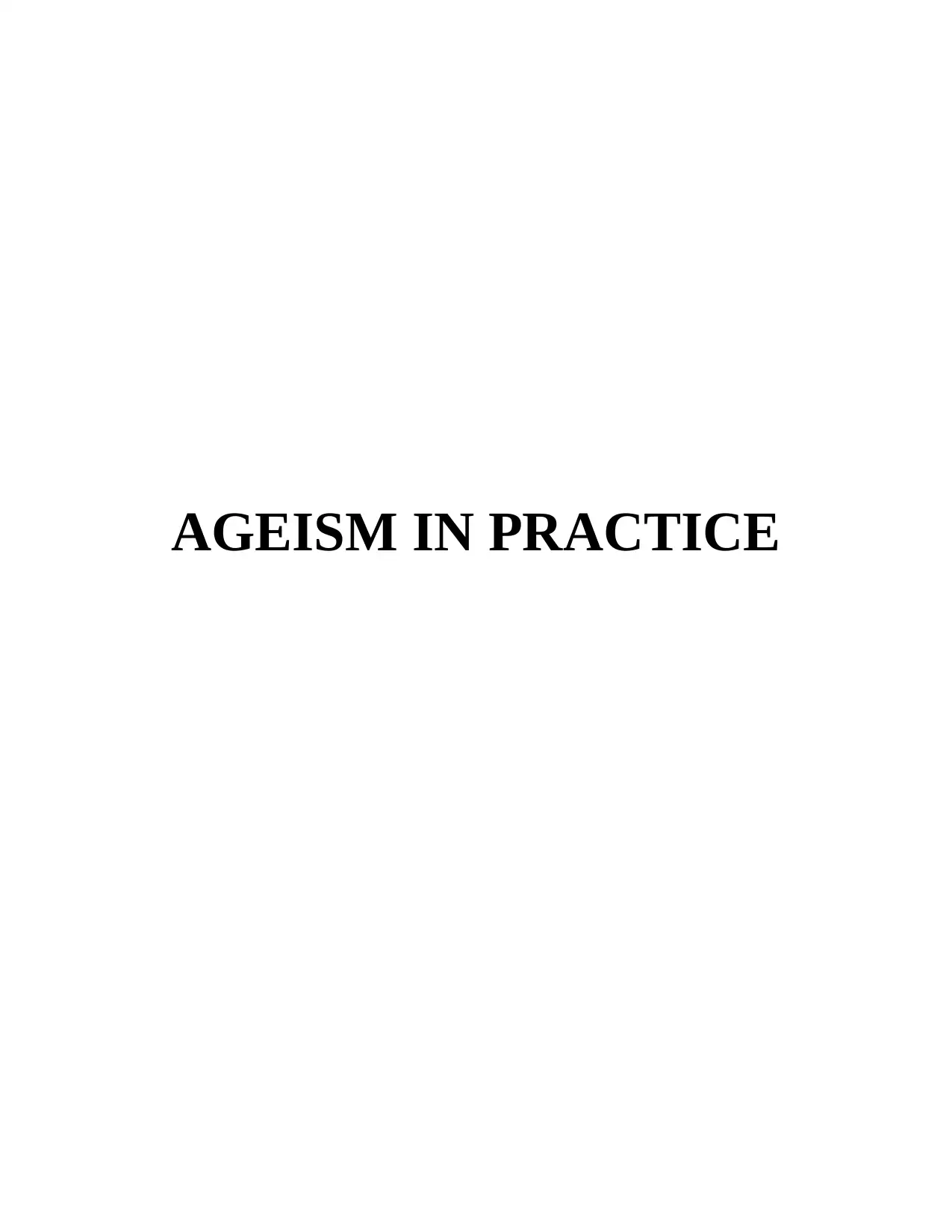
AGEISM IN PRACTICE
Paraphrase This Document
Need a fresh take? Get an instant paraphrase of this document with our AI Paraphraser
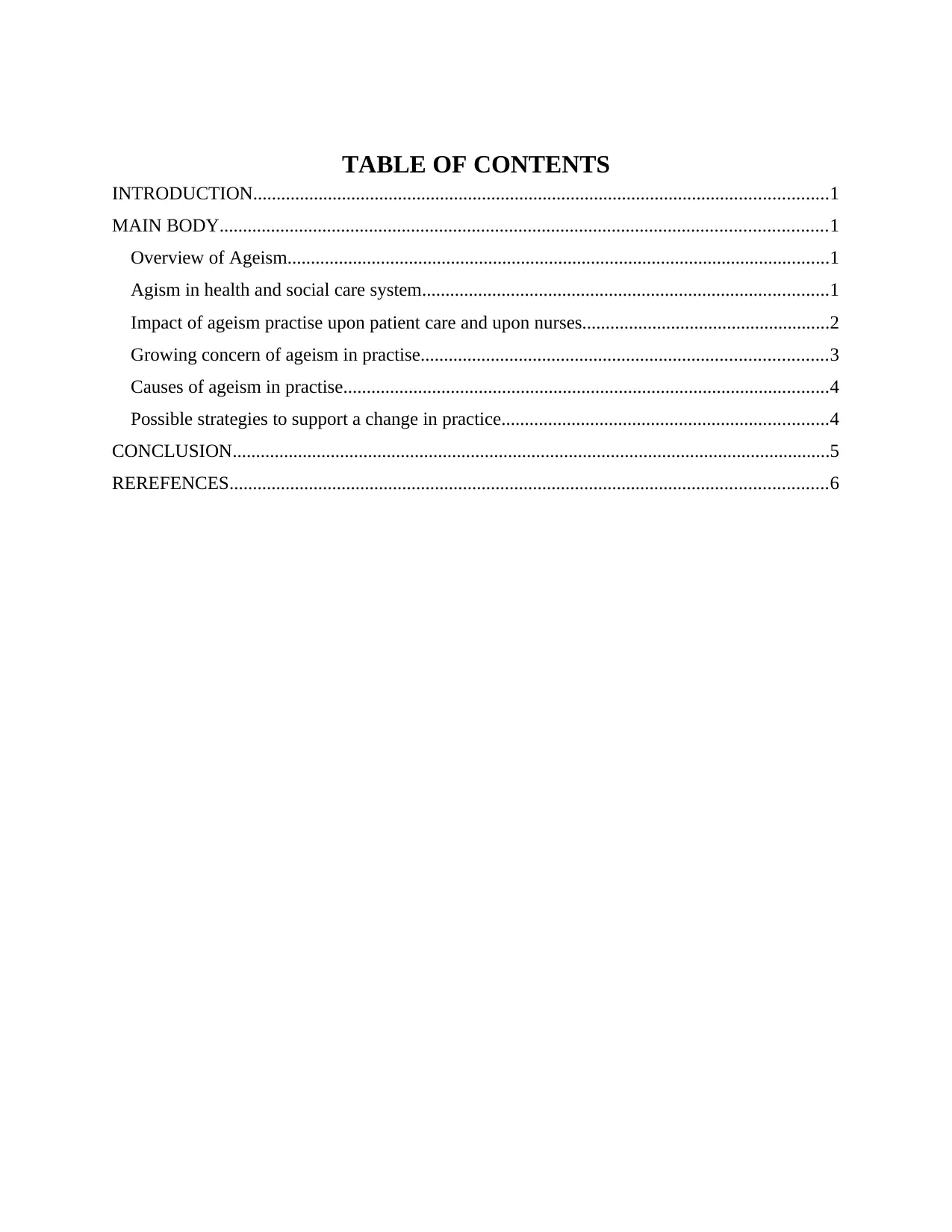
TABLE OF CONTENTS
INTRODUCTION...........................................................................................................................1
MAIN BODY..................................................................................................................................1
Overview of Ageism....................................................................................................................1
Agism in health and social care system.......................................................................................1
Impact of ageism practise upon patient care and upon nurses.....................................................2
Growing concern of ageism in practise.......................................................................................3
Causes of ageism in practise........................................................................................................4
Possible strategies to support a change in practice......................................................................4
CONCLUSION................................................................................................................................5
REREFENCES................................................................................................................................6
INTRODUCTION...........................................................................................................................1
MAIN BODY..................................................................................................................................1
Overview of Ageism....................................................................................................................1
Agism in health and social care system.......................................................................................1
Impact of ageism practise upon patient care and upon nurses.....................................................2
Growing concern of ageism in practise.......................................................................................3
Causes of ageism in practise........................................................................................................4
Possible strategies to support a change in practice......................................................................4
CONCLUSION................................................................................................................................5
REREFENCES................................................................................................................................6
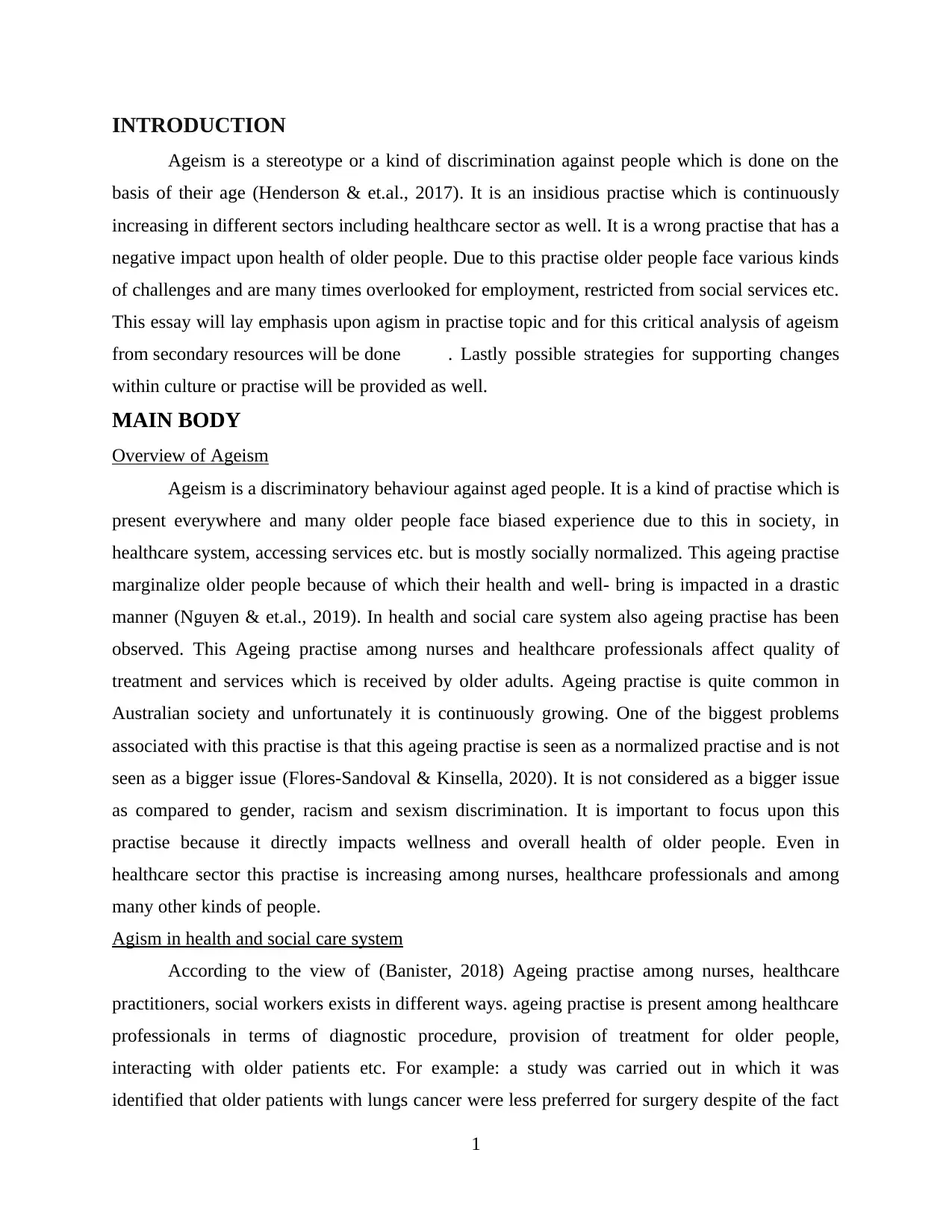
INTRODUCTION
Ageism is a stereotype or a kind of discrimination against people which is done on the
basis of their age (Henderson & et.al., 2017). It is an insidious practise which is continuously
increasing in different sectors including healthcare sector as well. It is a wrong practise that has a
negative impact upon health of older people. Due to this practise older people face various kinds
of challenges and are many times overlooked for employment, restricted from social services etc.
This essay will lay emphasis upon agism in practise topic and for this critical analysis of ageism
from secondary resources will be done . Lastly possible strategies for supporting changes
within culture or practise will be provided as well.
MAIN BODY
Overview of Ageism
Ageism is a discriminatory behaviour against aged people. It is a kind of practise which is
present everywhere and many older people face biased experience due to this in society, in
healthcare system, accessing services etc. but is mostly socially normalized. This ageing practise
marginalize older people because of which their health and well- bring is impacted in a drastic
manner (Nguyen & et.al., 2019). In health and social care system also ageing practise has been
observed. This Ageing practise among nurses and healthcare professionals affect quality of
treatment and services which is received by older adults. Ageing practise is quite common in
Australian society and unfortunately it is continuously growing. One of the biggest problems
associated with this practise is that this ageing practise is seen as a normalized practise and is not
seen as a bigger issue (Flores-Sandoval & Kinsella, 2020). It is not considered as a bigger issue
as compared to gender, racism and sexism discrimination. It is important to focus upon this
practise because it directly impacts wellness and overall health of older people. Even in
healthcare sector this practise is increasing among nurses, healthcare professionals and among
many other kinds of people.
Agism in health and social care system
According to the view of (Banister, 2018) Ageing practise among nurses, healthcare
practitioners, social workers exists in different ways. ageing practise is present among healthcare
professionals in terms of diagnostic procedure, provision of treatment for older people,
interacting with older patients etc. For example: a study was carried out in which it was
identified that older patients with lungs cancer were less preferred for surgery despite of the fact
1
Ageism is a stereotype or a kind of discrimination against people which is done on the
basis of their age (Henderson & et.al., 2017). It is an insidious practise which is continuously
increasing in different sectors including healthcare sector as well. It is a wrong practise that has a
negative impact upon health of older people. Due to this practise older people face various kinds
of challenges and are many times overlooked for employment, restricted from social services etc.
This essay will lay emphasis upon agism in practise topic and for this critical analysis of ageism
from secondary resources will be done . Lastly possible strategies for supporting changes
within culture or practise will be provided as well.
MAIN BODY
Overview of Ageism
Ageism is a discriminatory behaviour against aged people. It is a kind of practise which is
present everywhere and many older people face biased experience due to this in society, in
healthcare system, accessing services etc. but is mostly socially normalized. This ageing practise
marginalize older people because of which their health and well- bring is impacted in a drastic
manner (Nguyen & et.al., 2019). In health and social care system also ageing practise has been
observed. This Ageing practise among nurses and healthcare professionals affect quality of
treatment and services which is received by older adults. Ageing practise is quite common in
Australian society and unfortunately it is continuously growing. One of the biggest problems
associated with this practise is that this ageing practise is seen as a normalized practise and is not
seen as a bigger issue (Flores-Sandoval & Kinsella, 2020). It is not considered as a bigger issue
as compared to gender, racism and sexism discrimination. It is important to focus upon this
practise because it directly impacts wellness and overall health of older people. Even in
healthcare sector this practise is increasing among nurses, healthcare professionals and among
many other kinds of people.
Agism in health and social care system
According to the view of (Banister, 2018) Ageing practise among nurses, healthcare
practitioners, social workers exists in different ways. ageing practise is present among healthcare
professionals in terms of diagnostic procedure, provision of treatment for older people,
interacting with older patients etc. For example: a study was carried out in which it was
identified that older patients with lungs cancer were less preferred for surgery despite of the fact
1
⊘ This is a preview!⊘
Do you want full access?
Subscribe today to unlock all pages.

Trusted by 1+ million students worldwide
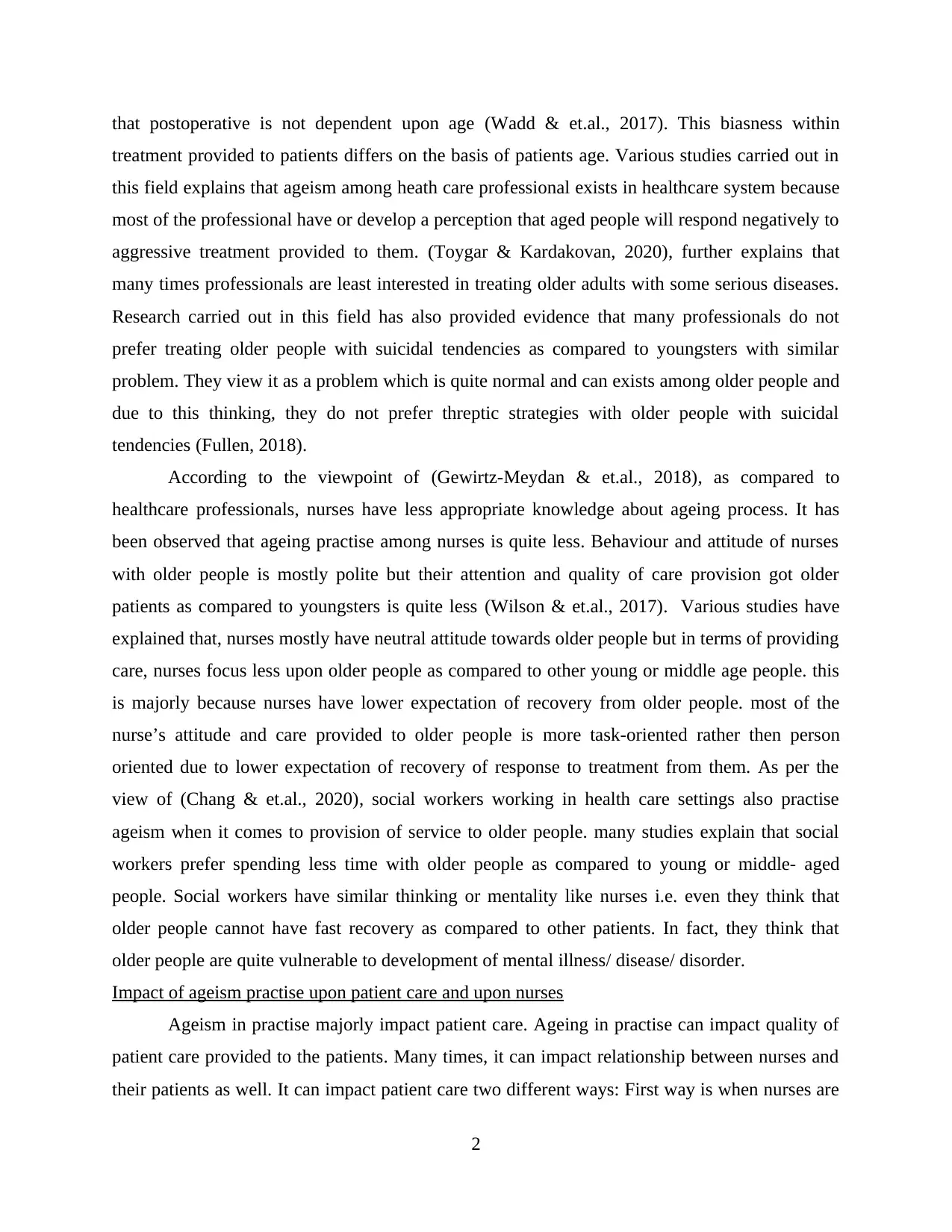
that postoperative is not dependent upon age (Wadd & et.al., 2017). This biasness within
treatment provided to patients differs on the basis of patients age. Various studies carried out in
this field explains that ageism among heath care professional exists in healthcare system because
most of the professional have or develop a perception that aged people will respond negatively to
aggressive treatment provided to them. (Toygar & Kardakovan, 2020), further explains that
many times professionals are least interested in treating older adults with some serious diseases.
Research carried out in this field has also provided evidence that many professionals do not
prefer treating older people with suicidal tendencies as compared to youngsters with similar
problem. They view it as a problem which is quite normal and can exists among older people and
due to this thinking, they do not prefer threptic strategies with older people with suicidal
tendencies (Fullen, 2018).
According to the viewpoint of (Gewirtz-Meydan & et.al., 2018), as compared to
healthcare professionals, nurses have less appropriate knowledge about ageing process. It has
been observed that ageing practise among nurses is quite less. Behaviour and attitude of nurses
with older people is mostly polite but their attention and quality of care provision got older
patients as compared to youngsters is quite less (Wilson & et.al., 2017). Various studies have
explained that, nurses mostly have neutral attitude towards older people but in terms of providing
care, nurses focus less upon older people as compared to other young or middle age people. this
is majorly because nurses have lower expectation of recovery from older people. most of the
nurse’s attitude and care provided to older people is more task-oriented rather then person
oriented due to lower expectation of recovery of response to treatment from them. As per the
view of (Chang & et.al., 2020), social workers working in health care settings also practise
ageism when it comes to provision of service to older people. many studies explain that social
workers prefer spending less time with older people as compared to young or middle- aged
people. Social workers have similar thinking or mentality like nurses i.e. even they think that
older people cannot have fast recovery as compared to other patients. In fact, they think that
older people are quite vulnerable to development of mental illness/ disease/ disorder.
Impact of ageism practise upon patient care and upon nurses
Ageism in practise majorly impact patient care. Ageing in practise can impact quality of
patient care provided to the patients. Many times, it can impact relationship between nurses and
their patients as well. It can impact patient care two different ways: First way is when nurses are
2
treatment provided to patients differs on the basis of patients age. Various studies carried out in
this field explains that ageism among heath care professional exists in healthcare system because
most of the professional have or develop a perception that aged people will respond negatively to
aggressive treatment provided to them. (Toygar & Kardakovan, 2020), further explains that
many times professionals are least interested in treating older adults with some serious diseases.
Research carried out in this field has also provided evidence that many professionals do not
prefer treating older people with suicidal tendencies as compared to youngsters with similar
problem. They view it as a problem which is quite normal and can exists among older people and
due to this thinking, they do not prefer threptic strategies with older people with suicidal
tendencies (Fullen, 2018).
According to the viewpoint of (Gewirtz-Meydan & et.al., 2018), as compared to
healthcare professionals, nurses have less appropriate knowledge about ageing process. It has
been observed that ageing practise among nurses is quite less. Behaviour and attitude of nurses
with older people is mostly polite but their attention and quality of care provision got older
patients as compared to youngsters is quite less (Wilson & et.al., 2017). Various studies have
explained that, nurses mostly have neutral attitude towards older people but in terms of providing
care, nurses focus less upon older people as compared to other young or middle age people. this
is majorly because nurses have lower expectation of recovery from older people. most of the
nurse’s attitude and care provided to older people is more task-oriented rather then person
oriented due to lower expectation of recovery of response to treatment from them. As per the
view of (Chang & et.al., 2020), social workers working in health care settings also practise
ageism when it comes to provision of service to older people. many studies explain that social
workers prefer spending less time with older people as compared to young or middle- aged
people. Social workers have similar thinking or mentality like nurses i.e. even they think that
older people cannot have fast recovery as compared to other patients. In fact, they think that
older people are quite vulnerable to development of mental illness/ disease/ disorder.
Impact of ageism practise upon patient care and upon nurses
Ageism in practise majorly impact patient care. Ageing in practise can impact quality of
patient care provided to the patients. Many times, it can impact relationship between nurses and
their patients as well. It can impact patient care two different ways: First way is when nurses are
2
Paraphrase This Document
Need a fresh take? Get an instant paraphrase of this document with our AI Paraphraser
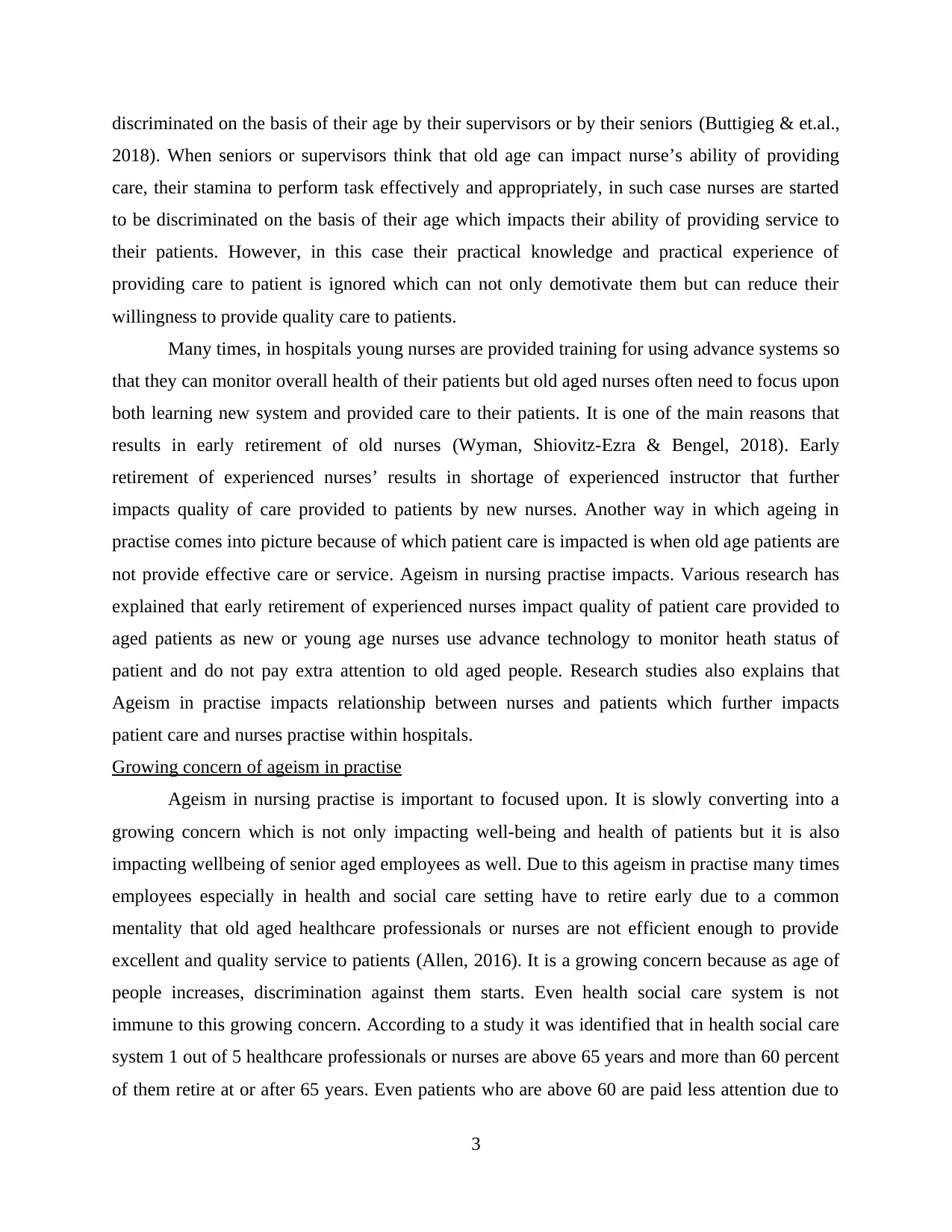
discriminated on the basis of their age by their supervisors or by their seniors (Buttigieg & et.al.,
2018). When seniors or supervisors think that old age can impact nurse’s ability of providing
care, their stamina to perform task effectively and appropriately, in such case nurses are started
to be discriminated on the basis of their age which impacts their ability of providing service to
their patients. However, in this case their practical knowledge and practical experience of
providing care to patient is ignored which can not only demotivate them but can reduce their
willingness to provide quality care to patients.
Many times, in hospitals young nurses are provided training for using advance systems so
that they can monitor overall health of their patients but old aged nurses often need to focus upon
both learning new system and provided care to their patients. It is one of the main reasons that
results in early retirement of old nurses (Wyman, Shiovitz-Ezra & Bengel, 2018). Early
retirement of experienced nurses’ results in shortage of experienced instructor that further
impacts quality of care provided to patients by new nurses. Another way in which ageing in
practise comes into picture because of which patient care is impacted is when old age patients are
not provide effective care or service. Ageism in nursing practise impacts. Various research has
explained that early retirement of experienced nurses impact quality of patient care provided to
aged patients as new or young age nurses use advance technology to monitor heath status of
patient and do not pay extra attention to old aged people. Research studies also explains that
Ageism in practise impacts relationship between nurses and patients which further impacts
patient care and nurses practise within hospitals.
Growing concern of ageism in practise
Ageism in nursing practise is important to focused upon. It is slowly converting into a
growing concern which is not only impacting well-being and health of patients but it is also
impacting wellbeing of senior aged employees as well. Due to this ageism in practise many times
employees especially in health and social care setting have to retire early due to a common
mentality that old aged healthcare professionals or nurses are not efficient enough to provide
excellent and quality service to patients (Allen, 2016). It is a growing concern because as age of
people increases, discrimination against them starts. Even health social care system is not
immune to this growing concern. According to a study it was identified that in health social care
system 1 out of 5 healthcare professionals or nurses are above 65 years and more than 60 percent
of them retire at or after 65 years. Even patients who are above 60 are paid less attention due to
3
2018). When seniors or supervisors think that old age can impact nurse’s ability of providing
care, their stamina to perform task effectively and appropriately, in such case nurses are started
to be discriminated on the basis of their age which impacts their ability of providing service to
their patients. However, in this case their practical knowledge and practical experience of
providing care to patient is ignored which can not only demotivate them but can reduce their
willingness to provide quality care to patients.
Many times, in hospitals young nurses are provided training for using advance systems so
that they can monitor overall health of their patients but old aged nurses often need to focus upon
both learning new system and provided care to their patients. It is one of the main reasons that
results in early retirement of old nurses (Wyman, Shiovitz-Ezra & Bengel, 2018). Early
retirement of experienced nurses’ results in shortage of experienced instructor that further
impacts quality of care provided to patients by new nurses. Another way in which ageing in
practise comes into picture because of which patient care is impacted is when old age patients are
not provide effective care or service. Ageism in nursing practise impacts. Various research has
explained that early retirement of experienced nurses impact quality of patient care provided to
aged patients as new or young age nurses use advance technology to monitor heath status of
patient and do not pay extra attention to old aged people. Research studies also explains that
Ageism in practise impacts relationship between nurses and patients which further impacts
patient care and nurses practise within hospitals.
Growing concern of ageism in practise
Ageism in nursing practise is important to focused upon. It is slowly converting into a
growing concern which is not only impacting well-being and health of patients but it is also
impacting wellbeing of senior aged employees as well. Due to this ageism in practise many times
employees especially in health and social care setting have to retire early due to a common
mentality that old aged healthcare professionals or nurses are not efficient enough to provide
excellent and quality service to patients (Allen, 2016). It is a growing concern because as age of
people increases, discrimination against them starts. Even health social care system is not
immune to this growing concern. According to a study it was identified that in health social care
system 1 out of 5 healthcare professionals or nurses are above 65 years and more than 60 percent
of them retire at or after 65 years. Even patients who are above 60 are paid less attention due to
3
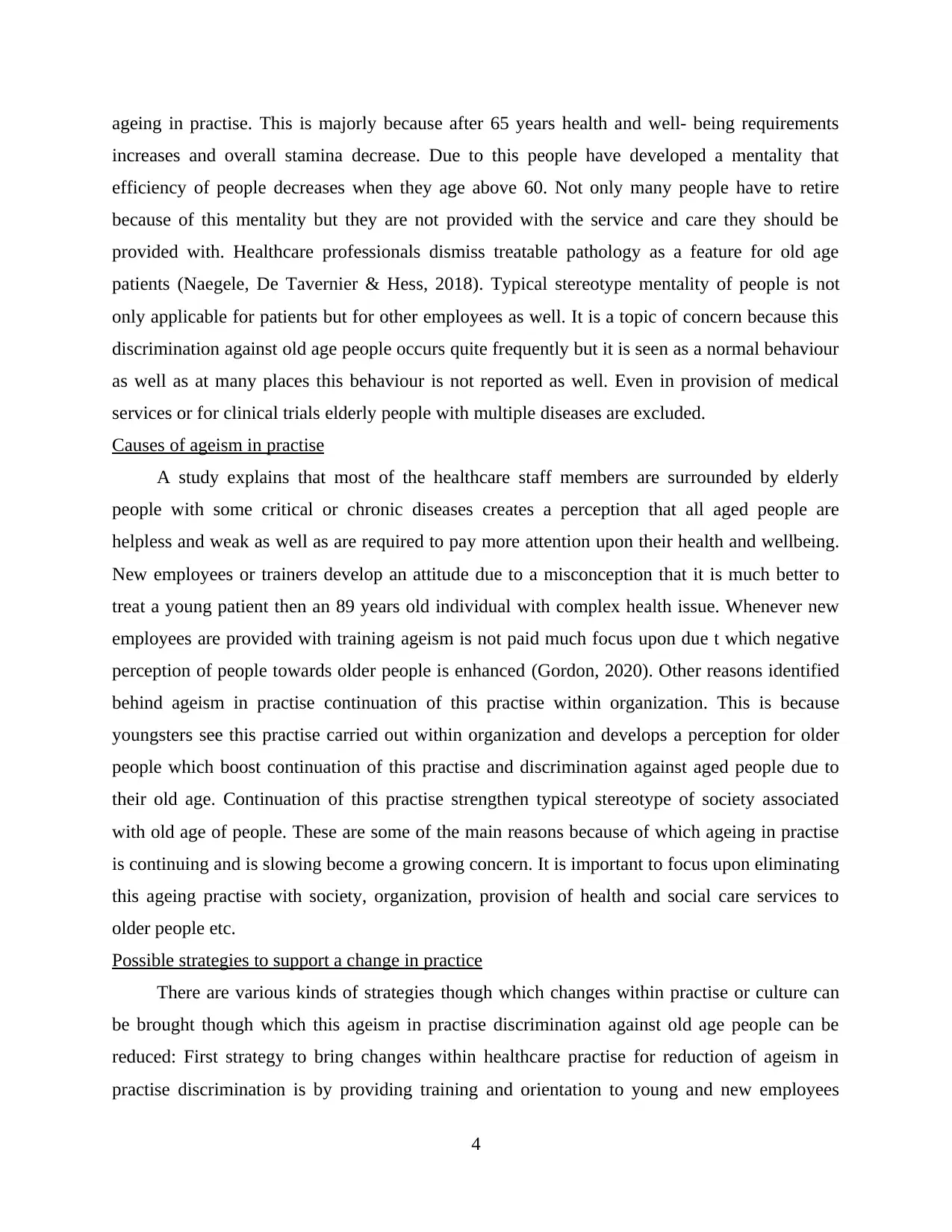
ageing in practise. This is majorly because after 65 years health and well- being requirements
increases and overall stamina decrease. Due to this people have developed a mentality that
efficiency of people decreases when they age above 60. Not only many people have to retire
because of this mentality but they are not provided with the service and care they should be
provided with. Healthcare professionals dismiss treatable pathology as a feature for old age
patients (Naegele, De Tavernier & Hess, 2018). Typical stereotype mentality of people is not
only applicable for patients but for other employees as well. It is a topic of concern because this
discrimination against old age people occurs quite frequently but it is seen as a normal behaviour
as well as at many places this behaviour is not reported as well. Even in provision of medical
services or for clinical trials elderly people with multiple diseases are excluded.
Causes of ageism in practise
A study explains that most of the healthcare staff members are surrounded by elderly
people with some critical or chronic diseases creates a perception that all aged people are
helpless and weak as well as are required to pay more attention upon their health and wellbeing.
New employees or trainers develop an attitude due to a misconception that it is much better to
treat a young patient then an 89 years old individual with complex health issue. Whenever new
employees are provided with training ageism is not paid much focus upon due t which negative
perception of people towards older people is enhanced (Gordon, 2020). Other reasons identified
behind ageism in practise continuation of this practise within organization. This is because
youngsters see this practise carried out within organization and develops a perception for older
people which boost continuation of this practise and discrimination against aged people due to
their old age. Continuation of this practise strengthen typical stereotype of society associated
with old age of people. These are some of the main reasons because of which ageing in practise
is continuing and is slowing become a growing concern. It is important to focus upon eliminating
this ageing practise with society, organization, provision of health and social care services to
older people etc.
Possible strategies to support a change in practice
There are various kinds of strategies though which changes within practise or culture can
be brought though which this ageism in practise discrimination against old age people can be
reduced: First strategy to bring changes within healthcare practise for reduction of ageism in
practise discrimination is by providing training and orientation to young and new employees
4
increases and overall stamina decrease. Due to this people have developed a mentality that
efficiency of people decreases when they age above 60. Not only many people have to retire
because of this mentality but they are not provided with the service and care they should be
provided with. Healthcare professionals dismiss treatable pathology as a feature for old age
patients (Naegele, De Tavernier & Hess, 2018). Typical stereotype mentality of people is not
only applicable for patients but for other employees as well. It is a topic of concern because this
discrimination against old age people occurs quite frequently but it is seen as a normal behaviour
as well as at many places this behaviour is not reported as well. Even in provision of medical
services or for clinical trials elderly people with multiple diseases are excluded.
Causes of ageism in practise
A study explains that most of the healthcare staff members are surrounded by elderly
people with some critical or chronic diseases creates a perception that all aged people are
helpless and weak as well as are required to pay more attention upon their health and wellbeing.
New employees or trainers develop an attitude due to a misconception that it is much better to
treat a young patient then an 89 years old individual with complex health issue. Whenever new
employees are provided with training ageism is not paid much focus upon due t which negative
perception of people towards older people is enhanced (Gordon, 2020). Other reasons identified
behind ageism in practise continuation of this practise within organization. This is because
youngsters see this practise carried out within organization and develops a perception for older
people which boost continuation of this practise and discrimination against aged people due to
their old age. Continuation of this practise strengthen typical stereotype of society associated
with old age of people. These are some of the main reasons because of which ageing in practise
is continuing and is slowing become a growing concern. It is important to focus upon eliminating
this ageing practise with society, organization, provision of health and social care services to
older people etc.
Possible strategies to support a change in practice
There are various kinds of strategies though which changes within practise or culture can
be brought though which this ageism in practise discrimination against old age people can be
reduced: First strategy to bring changes within healthcare practise for reduction of ageism in
practise discrimination is by providing training and orientation to young and new employees
4
⊘ This is a preview!⊘
Do you want full access?
Subscribe today to unlock all pages.

Trusted by 1+ million students worldwide
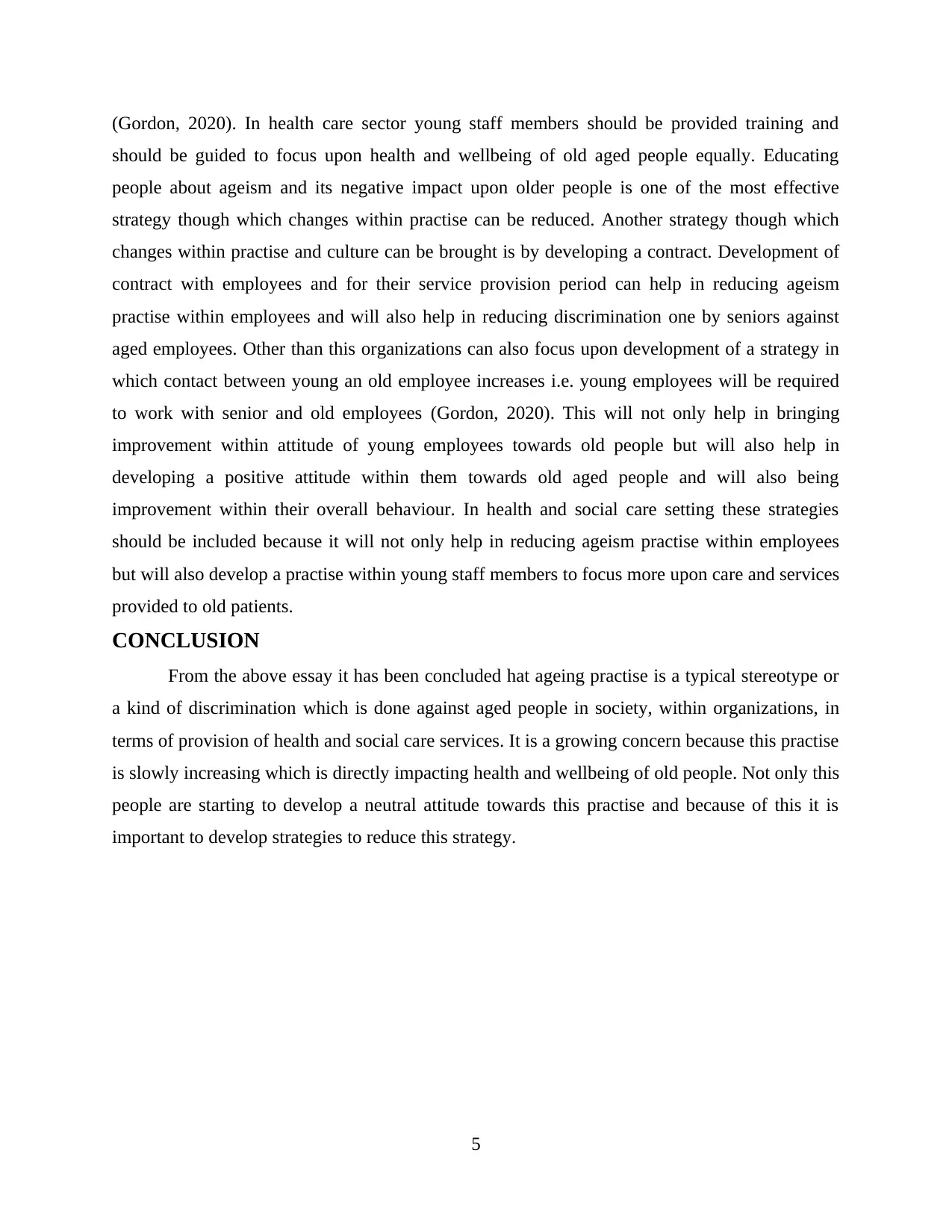
(Gordon, 2020). In health care sector young staff members should be provided training and
should be guided to focus upon health and wellbeing of old aged people equally. Educating
people about ageism and its negative impact upon older people is one of the most effective
strategy though which changes within practise can be reduced. Another strategy though which
changes within practise and culture can be brought is by developing a contract. Development of
contract with employees and for their service provision period can help in reducing ageism
practise within employees and will also help in reducing discrimination one by seniors against
aged employees. Other than this organizations can also focus upon development of a strategy in
which contact between young an old employee increases i.e. young employees will be required
to work with senior and old employees (Gordon, 2020). This will not only help in bringing
improvement within attitude of young employees towards old people but will also help in
developing a positive attitude within them towards old aged people and will also being
improvement within their overall behaviour. In health and social care setting these strategies
should be included because it will not only help in reducing ageism practise within employees
but will also develop a practise within young staff members to focus more upon care and services
provided to old patients.
CONCLUSION
From the above essay it has been concluded hat ageing practise is a typical stereotype or
a kind of discrimination which is done against aged people in society, within organizations, in
terms of provision of health and social care services. It is a growing concern because this practise
is slowly increasing which is directly impacting health and wellbeing of old people. Not only this
people are starting to develop a neutral attitude towards this practise and because of this it is
important to develop strategies to reduce this strategy.
5
should be guided to focus upon health and wellbeing of old aged people equally. Educating
people about ageism and its negative impact upon older people is one of the most effective
strategy though which changes within practise can be reduced. Another strategy though which
changes within practise and culture can be brought is by developing a contract. Development of
contract with employees and for their service provision period can help in reducing ageism
practise within employees and will also help in reducing discrimination one by seniors against
aged employees. Other than this organizations can also focus upon development of a strategy in
which contact between young an old employee increases i.e. young employees will be required
to work with senior and old employees (Gordon, 2020). This will not only help in bringing
improvement within attitude of young employees towards old people but will also help in
developing a positive attitude within them towards old aged people and will also being
improvement within their overall behaviour. In health and social care setting these strategies
should be included because it will not only help in reducing ageism practise within employees
but will also develop a practise within young staff members to focus more upon care and services
provided to old patients.
CONCLUSION
From the above essay it has been concluded hat ageing practise is a typical stereotype or
a kind of discrimination which is done against aged people in society, within organizations, in
terms of provision of health and social care services. It is a growing concern because this practise
is slowly increasing which is directly impacting health and wellbeing of old people. Not only this
people are starting to develop a neutral attitude towards this practise and because of this it is
important to develop strategies to reduce this strategy.
5
Paraphrase This Document
Need a fresh take? Get an instant paraphrase of this document with our AI Paraphraser
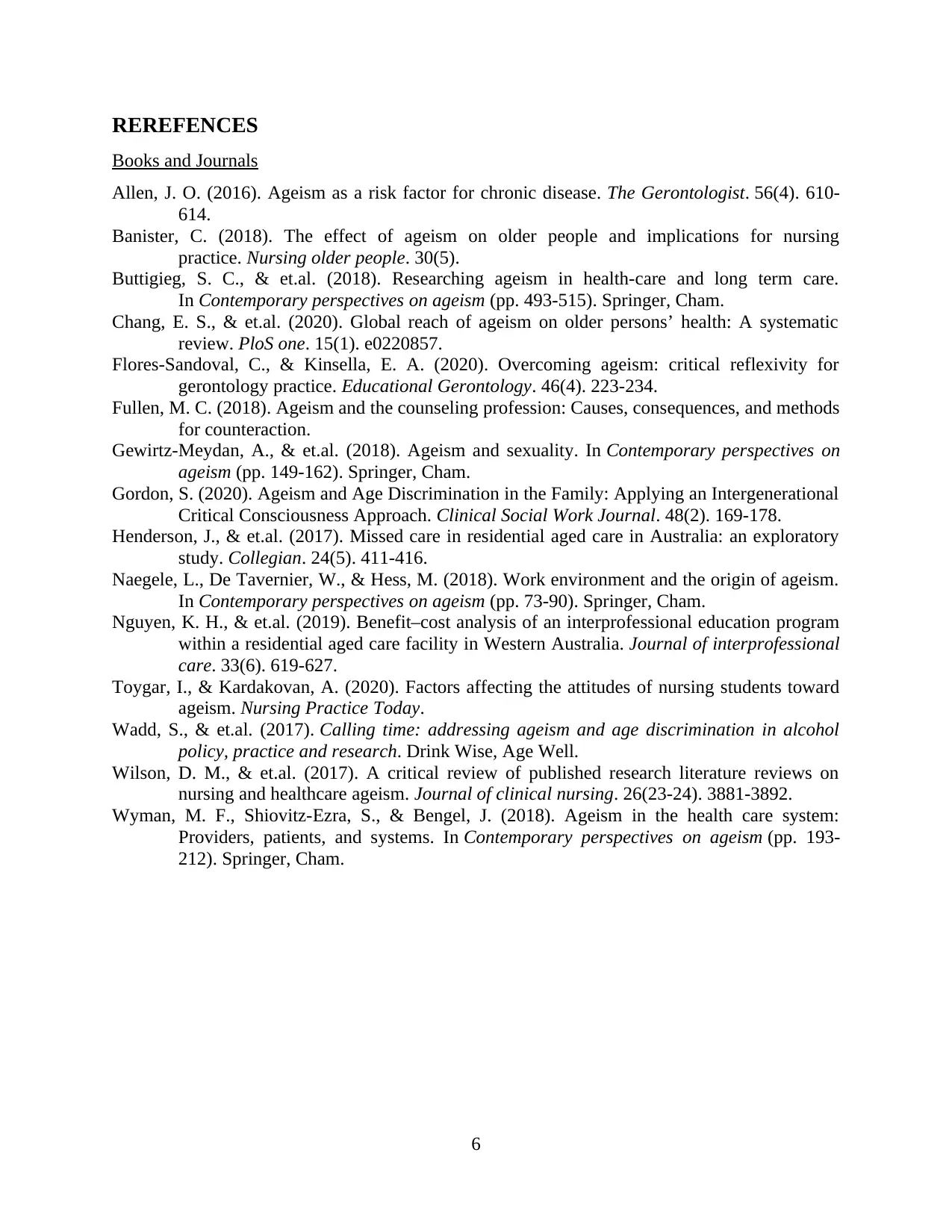
REREFENCES
Books and Journals
Allen, J. O. (2016). Ageism as a risk factor for chronic disease. The Gerontologist. 56(4). 610-
614.
Banister, C. (2018). The effect of ageism on older people and implications for nursing
practice. Nursing older people. 30(5).
Buttigieg, S. C., & et.al. (2018). Researching ageism in health-care and long term care.
In Contemporary perspectives on ageism (pp. 493-515). Springer, Cham.
Chang, E. S., & et.al. (2020). Global reach of ageism on older persons’ health: A systematic
review. PloS one. 15(1). e0220857.
Flores-Sandoval, C., & Kinsella, E. A. (2020). Overcoming ageism: critical reflexivity for
gerontology practice. Educational Gerontology. 46(4). 223-234.
Fullen, M. C. (2018). Ageism and the counseling profession: Causes, consequences, and methods
for counteraction.
Gewirtz-Meydan, A., & et.al. (2018). Ageism and sexuality. In Contemporary perspectives on
ageism (pp. 149-162). Springer, Cham.
Gordon, S. (2020). Ageism and Age Discrimination in the Family: Applying an Intergenerational
Critical Consciousness Approach. Clinical Social Work Journal. 48(2). 169-178.
Henderson, J., & et.al. (2017). Missed care in residential aged care in Australia: an exploratory
study. Collegian. 24(5). 411-416.
Naegele, L., De Tavernier, W., & Hess, M. (2018). Work environment and the origin of ageism.
In Contemporary perspectives on ageism (pp. 73-90). Springer, Cham.
Nguyen, K. H., & et.al. (2019). Benefit–cost analysis of an interprofessional education program
within a residential aged care facility in Western Australia. Journal of interprofessional
care. 33(6). 619-627.
Toygar, I., & Kardakovan, A. (2020). Factors affecting the attitudes of nursing students toward
ageism. Nursing Practice Today.
Wadd, S., & et.al. (2017). Calling time: addressing ageism and age discrimination in alcohol
policy, practice and research. Drink Wise, Age Well.
Wilson, D. M., & et.al. (2017). A critical review of published research literature reviews on
nursing and healthcare ageism. Journal of clinical nursing. 26(23-24). 3881-3892.
Wyman, M. F., Shiovitz-Ezra, S., & Bengel, J. (2018). Ageism in the health care system:
Providers, patients, and systems. In Contemporary perspectives on ageism (pp. 193-
212). Springer, Cham.
6
Books and Journals
Allen, J. O. (2016). Ageism as a risk factor for chronic disease. The Gerontologist. 56(4). 610-
614.
Banister, C. (2018). The effect of ageism on older people and implications for nursing
practice. Nursing older people. 30(5).
Buttigieg, S. C., & et.al. (2018). Researching ageism in health-care and long term care.
In Contemporary perspectives on ageism (pp. 493-515). Springer, Cham.
Chang, E. S., & et.al. (2020). Global reach of ageism on older persons’ health: A systematic
review. PloS one. 15(1). e0220857.
Flores-Sandoval, C., & Kinsella, E. A. (2020). Overcoming ageism: critical reflexivity for
gerontology practice. Educational Gerontology. 46(4). 223-234.
Fullen, M. C. (2018). Ageism and the counseling profession: Causes, consequences, and methods
for counteraction.
Gewirtz-Meydan, A., & et.al. (2018). Ageism and sexuality. In Contemporary perspectives on
ageism (pp. 149-162). Springer, Cham.
Gordon, S. (2020). Ageism and Age Discrimination in the Family: Applying an Intergenerational
Critical Consciousness Approach. Clinical Social Work Journal. 48(2). 169-178.
Henderson, J., & et.al. (2017). Missed care in residential aged care in Australia: an exploratory
study. Collegian. 24(5). 411-416.
Naegele, L., De Tavernier, W., & Hess, M. (2018). Work environment and the origin of ageism.
In Contemporary perspectives on ageism (pp. 73-90). Springer, Cham.
Nguyen, K. H., & et.al. (2019). Benefit–cost analysis of an interprofessional education program
within a residential aged care facility in Western Australia. Journal of interprofessional
care. 33(6). 619-627.
Toygar, I., & Kardakovan, A. (2020). Factors affecting the attitudes of nursing students toward
ageism. Nursing Practice Today.
Wadd, S., & et.al. (2017). Calling time: addressing ageism and age discrimination in alcohol
policy, practice and research. Drink Wise, Age Well.
Wilson, D. M., & et.al. (2017). A critical review of published research literature reviews on
nursing and healthcare ageism. Journal of clinical nursing. 26(23-24). 3881-3892.
Wyman, M. F., Shiovitz-Ezra, S., & Bengel, J. (2018). Ageism in the health care system:
Providers, patients, and systems. In Contemporary perspectives on ageism (pp. 193-
212). Springer, Cham.
6
1 out of 8
Related Documents
Your All-in-One AI-Powered Toolkit for Academic Success.
+13062052269
info@desklib.com
Available 24*7 on WhatsApp / Email
![[object Object]](/_next/static/media/star-bottom.7253800d.svg)
Unlock your academic potential
Copyright © 2020–2025 A2Z Services. All Rights Reserved. Developed and managed by ZUCOL.





